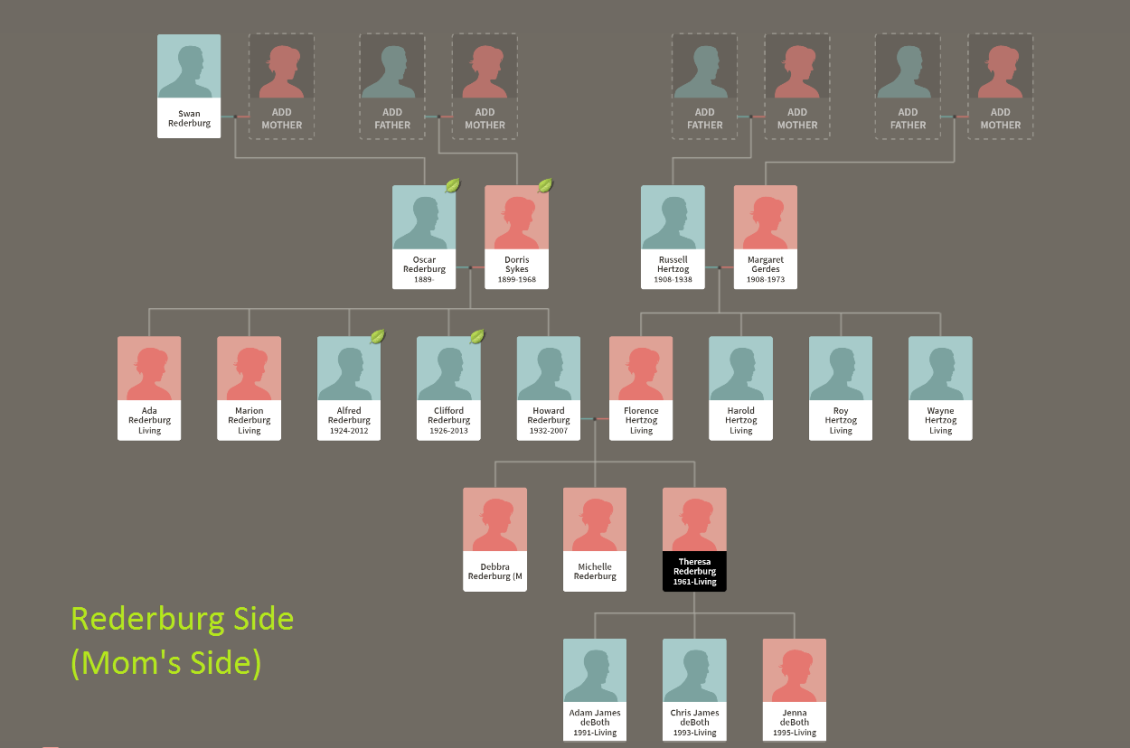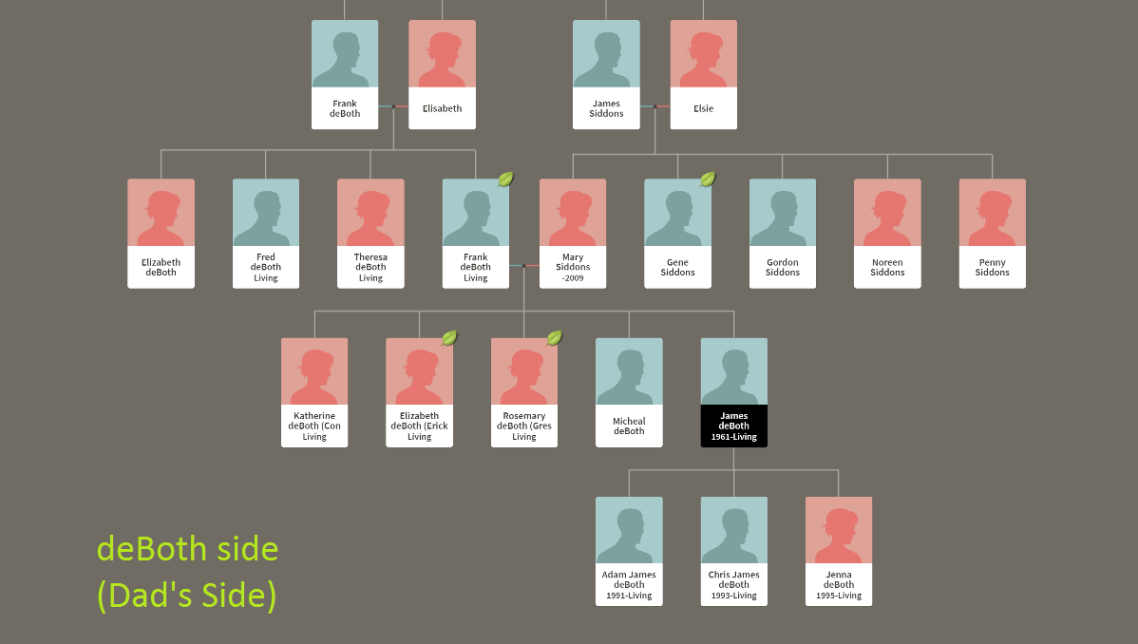In order to think about my settler story, I must think about to where I am from as well as where my family is from. If you were to ask me to ‘categorize’ my heritage, I would tell you that the cultural roots of my family are connected to Holland, Germany, England and Canada. Below, I have created two simple family trees of my connection to my family members who made the choice to immigrate from other parts of the world to come to Canada, along with a bit of backstory to go with them.
The Rederburg Back Story
Grandpa (Howard Rederburg)
On my mother’s side, I have ties to Sweden and England. My mother’s maiden name is Rederburg; however, when I research my family members before the 1850’s I have to look under the name Jacobson as this was our family name before this time. My great- great- great- great grandfather (not sure of his name) was in the military in Germany at one point. He met a man who’s last name was Rederburg. During this time, there was an abundance of Jacobson’s in Sweden, so he decided to change their last name to Rederburg.
My great-great grandfather Swan Rederburg made the choice to leave Sweden with his family and ‘settled’ in Wheaton, Minesota. At this time, the Canadian Government has parcels of land up for purchase throughout the prairies. Swan moved with his family by Wagon to Canada and purchased a piece of land by Midale, Saskatchewan. They wanted to be farmers and ‘own’ some land. One of Swan’s children, Oscar, or my great-grandfather, met a young lady by the name of Doris Sykes and soon they got married. Doris’s family was from Carievale, SK, which is where her family created their home when they came from England to Canada.
Oscar worked as a banker for a few years in Griffin, SK, before purchasing some land just outside of Benson, SK. Doris and Oscar had five children: Alfred, Clifford, Aida, Marion and Howard, who is my grandfather. Howard attended the school in Benson until he was in grade 8 and then he started to work for a farmer. Soon, he wanted his own land. Starting when he was 16, every winter he would go to Regina and work for Sears as a transport truck driver. As he spent the whole winter in Regina, he started to attend a youth group at one of the United Churches in the city. This is where he met Florence Hertzog, or my grandmother. Starting going to a young people’s youth group at the united church in Regina. He met Florence Hertzog. Howard had some land that he and his brothers farmed and then after they got married they bought more. They had three daughters; Theresa, Michelle, Debbie.
Grandma (Florence Hertzog)
My Grandma grew up without a father as he passed away when she was 2. His name was Russell and he came to Canada from Germany. Margaret Gerdes, was my grandmother’s mom. She came from England with her family. Margaret and Russell met each other on the boat coming to Canada. They eventually decided to live and raise a family in Regina, SK. Wayne, Roy, Harold and Florence are the four children of Margaret and Russell.

The deBoth Back Story
Grandpa (Frank deBoth)
On my dad’s side of the family, I have ties to Holland and England. My great grandparents on the deBoth side, immigrated to Canada from Holland. Their names, Frank and Elizabeth deBoth settled in Saskatchewan and raised four children: Frank, Theresa, Fred and Elizabeth. My last name is often spelt “de Both” or “Deboth”, however, I have always spelt it “deBoth” as in “de-both-of-us”. This has caused me to have a more difficult time figuring out a backstory for this side of the family. My grandpa does not talk much about his parents, so I am still working to figure out more information about the deBoth side of my family.
Grandma (Mary Siddons)
My grandma’s parents, Elsie and James Siddons, moved from England to Canada. They chose Saskatchewan as their landing pad and raised 5 children: Penny, Mary, Gene, Gordon and Noreen. Since my Grandma and her siblings have passed away, I am still working to figure out more information about the Siddon’s side of my family as well.

Considering Myself As Settler
I was faced with considering myself as a settler when my group decided to pick the topic of the term settler for our group facilitation. I was intrigued by this topic because I still have difficulty calling myself a settler. During the preparation for this seminar, I read various materials regarding the term settler. One passage stood out to me and I used it as a part of or seminar as it helped me understand a bit more about what the term settler means to me.
“Settler. The word voices relationships to structures and processes in Canada today, to the histories of our peoples on this land, to Indigenous peoples, and to our own day-to-day choices and actions. Settler. This word turns us towards uncomfortable realisations, difficult subjects and potential complicity in systems of dispossession and violence. Settler. The word represents a tool, a way of understanding and choosing to act differently. A tool we can use to confront the fundamental problems and injustices in Canada today. Settler. It is analytical, personal. and uncomfortable. It can be an identity that we claim or deny, but that we inevitably live and embody. It is who we are, as a people, on these lands. ”
” We are Settler Canadians.”
Lowman, E. & Barker, A. (2015); Settler Identity and Colonialism in 21st Century Canada.; Fernwood Publishing, Black Point, Nova Scotia. Print. Pg. 2.
Reading this passage solidified for me that I am a settler. As a part of my treaty walk, I have been looking for opportunities to learn more and expand my learning or perhaps unlearn some of my colonial ways. In the opportunity of reading about the term settler, I was awoken to the idea that the reason that I have had great difficulty with calling myself a settler is because it disrupts my identity that was rooted in being a Canadian citizen. I have realized that I am a settler as my ancestors came from Holland and started a new life for themselves in Canad. After this reading, I tried to tell myself that the term settler is not a bad one for me to associated with; however, it is a part of my truth and my life story and in order for me to truly understand who I am, I must accept and adapt that term.
In saying this, I naturally bring up the topic of naming oneself. From the beginning of my ECCU journey until now, I have realized that I am a settler, but I am not satisfied with that term. The passion and connection that I have felt towards learning about and engaging with Indigenous Peoples worldview and knowledge has shown me that I am a Settler who wants to know more. One of my peers, April, named herself as a “Seeking Settler” and this far in my journey, I would say that this is the term that I would name myself as. However, I know that the more I learn, and the more I explore what it means to be a treaty person, that I acquire my own name for myself. That is all for now.
Until next time,
Miss Jenna deBoth


 Photo Credit:
Photo Credit: 




